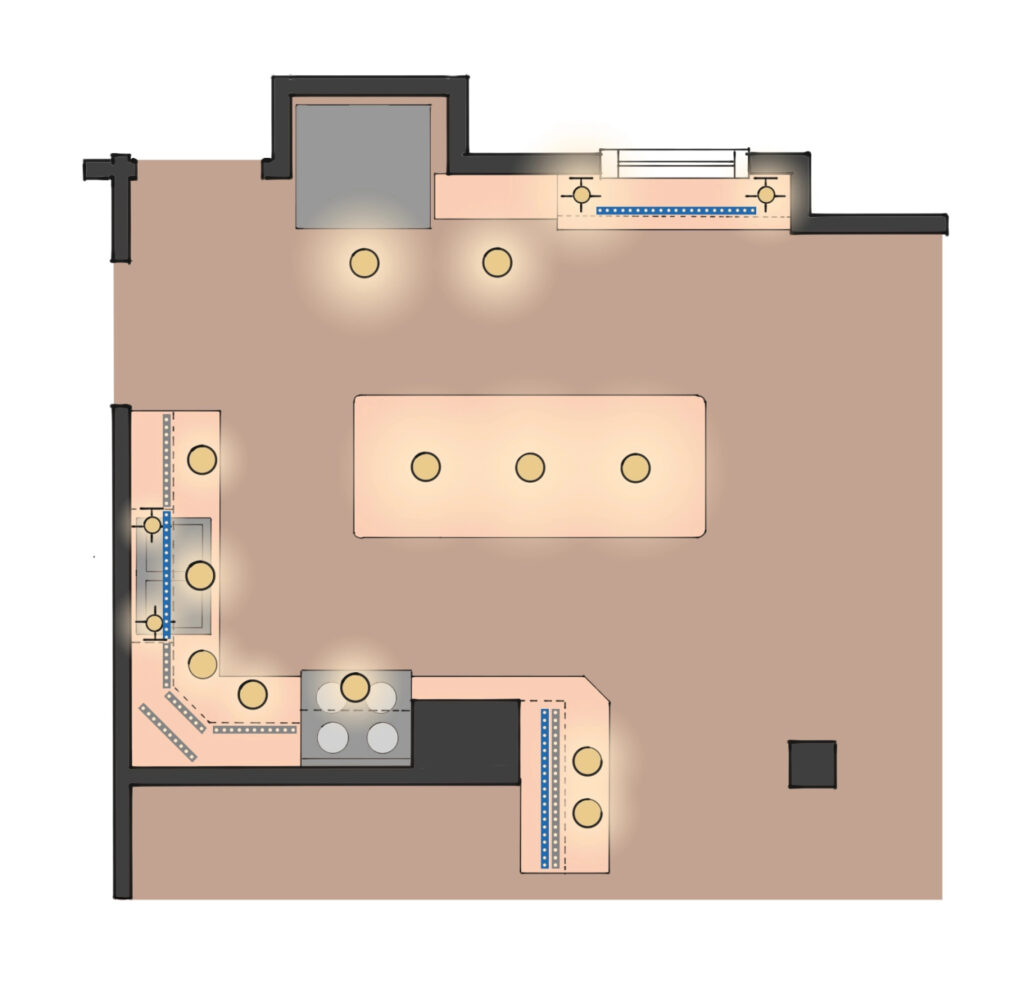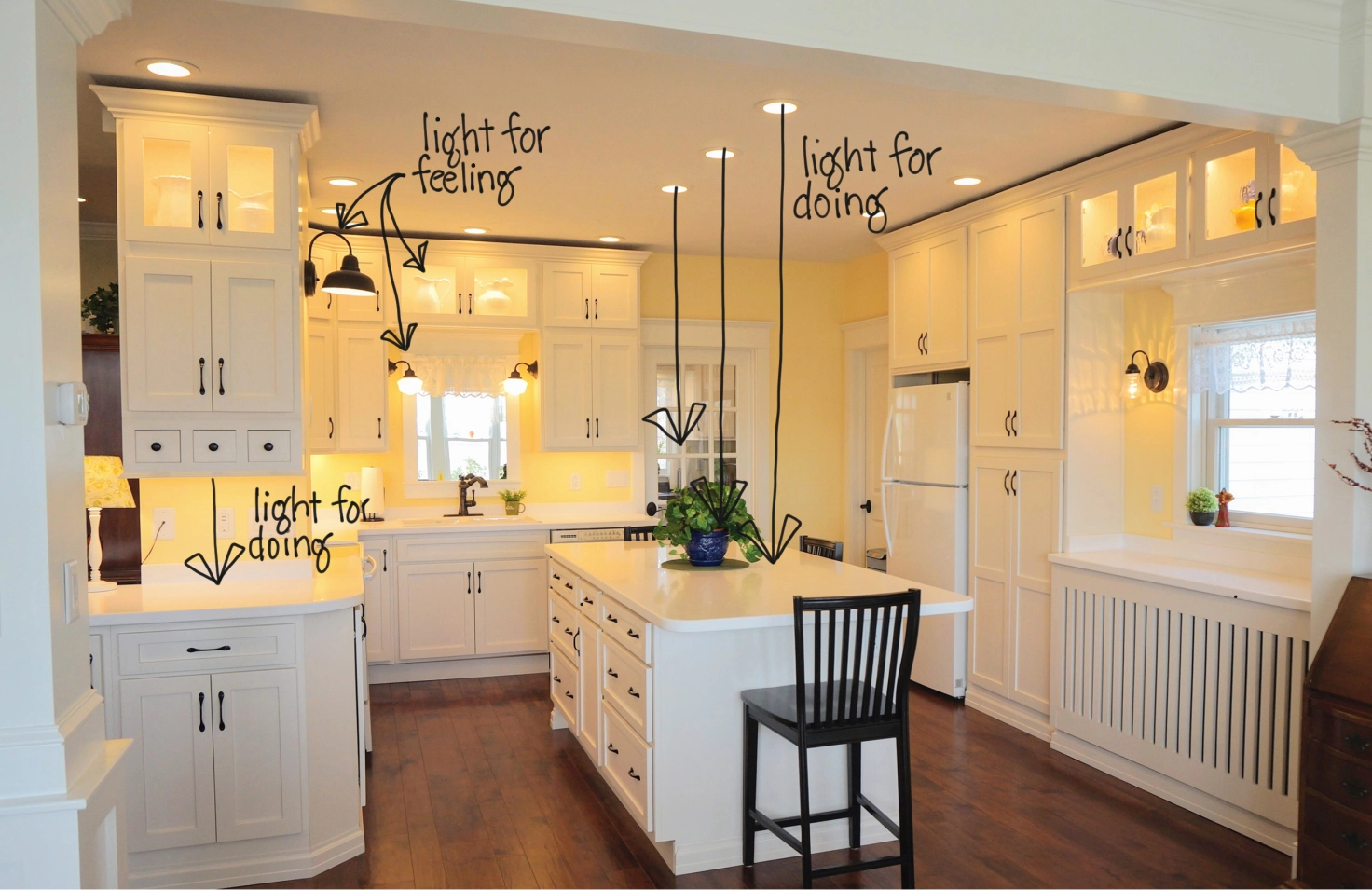Most folks I know never ask me to advise them on lighting their living rooms, but I get called in often to take a look at kitchens. Modern lifestyles place a much higher emphasis on kitchens than when many of our homes were built, and it makes sense that lighting these spaces has become more important. Kitchens are often the hub of daily family life, and have grown to include islands, breakfast nooks, bars, prep sinks, walk-in-pantries, and a bevy of amenities that would have amazed our grandparents.
I think one reason I get asked to do so many kitchen projects is that bad lighting in a kitchen is not so easily fixed. Adding a few good lamps to your living room might transform the space, but it isn’t practical to put six table lamps on your counter next to the toaster oven, coffee maker, and stand mixer. Add in that cooking grease and food detritus can destroy lamp shades overnight, and other solutions are clearly needed.
Developing good lighting for kitchens begins the same way as in a living room- by determining what you do there. Fortunately, most kitchen work is contained on countertops, islands, and bars or peninsulas, and that makes lighting kitchens quite straightforward. In kitchens, I almost always begin by layering in light for doing.
A common answer to what happens in a kitchen is “cooking,” but that is not quite enough information. First of all, “cooking” can mean very different things to different people. When I was a college student, cooking dinner meant ordering pizza or putting together nachos. Fast forward twenty years and cooking in our kitchen means hours of chopping vegetables, assembling stews and simmering soups, chopping and roasting fresh vegetables, baking breads and muffins, and making our own granola. I didn’t need much light as a twenty-year-old to operate the microwave, but now we need so much more.

A layer of recessed downlights- show as circles- push light to the countertops. Undercabinet lights- shown as strips- fill in the shadows.
How do you cook in your kitchen? Do you stumble to the coffee maker in the pre-dawn hours, fumbling in dark cabinets for the filters? Are you home for lunch mid-day on Saturday, when sunshine fills the room? Do you return to the kitchen after dinner to make popcorn for the movie? It pays to do a little thinking about how- and when- you cook in your kitchen to make sure you have the right light at the right time.
Now stop and think for a minute about the different activities that take place in your kitchen besides cooking. My wife has a desk area in our current kitchen complete with her laptop, note paper, a wall calendar, stationary, and other typical desk items. Does that make our kitchen an office? Yes- some of the time. Some of you likely sit at an island or kitchen table to sort mail, pay the bills, or do homework. Maybe you have a small cookbook library in your kitchen, a breakfast nook for eating, a television, or a pantry. Each of these places and activities might benefit from a different kind of light for doing. Doing homework might benefit from Sunny Day Theory-inspired lighting, while finishing up dinner is more likely to feel right in a Starry Night-inspired setting.
I was recently asked to craft a lighting design for a new kitchen, set to replace an ageing and dark space in a family farmhouse. The client had an understanding that lighting could play a huge role in the functionality and beauty of the kitchen, and she did not want to make a mistake. As caretaker of the family farm, she wanted to complete the kitchen as a gift to the next home-owners, to leave it as a legacy of improvement for future generations. The pressure was high to deliver a good solution, and to do so within a reasonable budget.

I typically begin by planning lights for the countertops and cooktop, arguably the most important surfaces in a kitchen. LED ribbon lighting, often called tape light, was applied underneath upper cabinets to light the counters below and fill what is typically a very dark area of the kitchen (and of course the wrong area to be dark!). While a bright enough LED ribbon could provide all the light needed for cooking, it might leave the space looking dark and uncomfortable, and the client and I both wanted this kitchen to be light and bright.
To further boost light on the countertops, I placed recessed down lights directly above the counters. Whenever possible, I align the downlights with the center of cabinets, so a nice scallop of light washes across the cabinet doors. The result is light for doing on the counter, light on the cabinet doors, light inside the cabinets when the doors are opened, and a soft layer of diffuse ambient light bounced off the cabinets. All this can be achieved without glare if the recessed lights are truly recessed (there are some modern “low-profile” LED downlights that create more glare than I want to normally use), and together with the undercabinet LED ribbon light, the kitchen becomes quite functional.
While light for doing is of critical importance in most kitchens, that does not mean that light for knowing and light for feeling are not needed. This kitchen is layered with both, and a control system is included to make changing light easy. And storytelling? That comes through loud and clear in the sensible, classic, barn and school-styled light fixtures in this kitchen.
